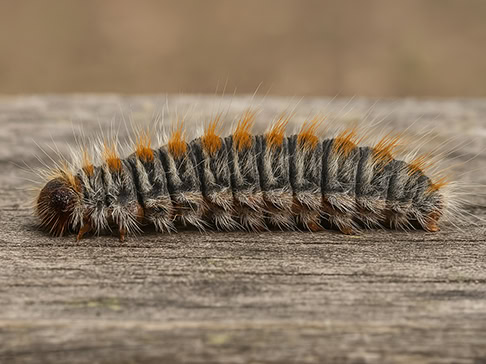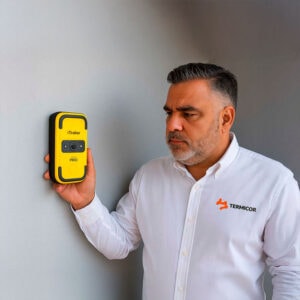The pine processionary is one of the most well-known – and dangerous – pests in our forests and gardens. In Mallorca, their presence is especially active between late winter and spring, when caterpillars descend from the trees in long rows looking to bury themselves to complete their life cycle. Although many believe that the problem ends when the pockets disappear, the truth is that April is a key month: caterpillars are still active and can pose a risk to people, pets and plants.
In this article we explain what the processionary is, why it is still dangerous in April, how to identify its presence and what you can do to protect your environment if you still see caterpillars in your garden.
What is the pine processionary?
The Thaumetopoea pityocampa, commonly known as the pine processionary, is a nocturnal butterfly that in its larval stage causes significant damage to trees such as Pinus nigra, Pinus sylvestris or Pinus canariensis. These caterpillars are easily recognizable by their behavior: they march in a row, one after the other, when they come down from the tree to bury themselves and begin their transformation into chrysalises.
During this larval stage, the processionary feeds on needles (pine leaves), seriously weakening the trees and leaving them exposed to other pests or diseases.
What is its life cycle?
The life cycle of the processionary adapts to the Mediterranean climate, such as the one we have in Mallorca. This is its approximate development throughout the year:
- Summer (July-August): Adults (butterflies) emerge from the ground, mate, and females lay eggs in the tops of pine trees.
- Late summer to autumn: larvae are born, which begin to feed on needles.
- Winter: the caterpillars are grouped in silk pockets to protect themselves from the cold.
- Spring (March-April): they descend from the tree in a row to bury themselves and form the pupa under the soil.
- The following summer : after metamorphosis, they emerge as nocturnal butterflies and the cycle repeats itself.
Why is the processionary dangerous in April?
Although the pockets in the trees have already disappeared, April is still a critical month. This is when the caterpillars are most visible, going down the trunk or ground in procession, just before burying themselves.
Here are the main risks:
- Danger to pets: The stinging hairs of the caterpillar can cause serious reactions in dogs and cats, from tongue inflammation to necrosis if not acted upon in time.
- Reactions in people: contact with the hairs of the processionary can cause hives, conjunctivitis or asthmatic attacks, especially in children.
- Damage to public health: its hairs remain in the air and on the ground, which can affect those who walk through green areas without direct contact with the caterpillar.
- Future colonies: if not properly controlled, the caterpillars burrow and complete their cycle, giving rise to new butterflies in summer that will restart the process.
What to do if you see processionaries in your garden?
April is the ideal time to act if you still detect the presence of caterpillars. Here’s a handy guide:
1. Avoid direct contact
Neither you nor your pets should approach the caterpillars. If you see them on the ground or walking in a row, move away immediately and avoid stepping on them or sweeping them without protection.
2. Don’t use homemade insecticides
Using products without control can disperse stinging hairs or harm other beneficial species. In addition, treatments should be specific to this pest, such as the use of Bacillus thuringiensis, but applied by professionals.
3. Locate burial sites
Caterpillars usually bury themselves near the trunk of the tree or in areas of loose soil. It is important to monitor these points and, if activity is detected, act immediately.
4. Consult with a specialized company
At Termicor we offer preventive and shock treatments against the processionary, even out of season. We assess the situation, act safely and advise you on how to avoid further infestations.
Check here our specialized service in processionary control.
How can pine processionary caterpillars be prevented?
The best way to avoid damage is to anticipate. Below, we explain the main prevention techniques we use at Termicor:
Trap tapes on logs
Installed between December and February, these tapes capture the caterpillars as they come down from the tree, preventing them from reaching the ground and burying themselves.
Treatments with Bacillus thuringiensis
This biological insecticide attacks young larvae, preventing their development without affecting the rest of the ecosystem. It is applied in autumn, when the first larvae are born.
Pruning and removal of pockets
Manual removal of pockets, well done and in the right months, can significantly reduce the caterpillar population. It is key to do so with adequate protection to avoid contact with stinging hairs.
Pheromone traps
In spring and summer, they capture adult males before mating, reducing reproduction.
What is the habitat of the processionary?
The pine processionary is mainly found in areas of pine forests and Mediterranean forests, although it has also adapted to parks, gardens and urban areas where there are planted pines.
In Mallorca it is present practically all over the island, especially in areas with Pinus halepensis or Pinus pinea. The warm climate favors their reproduction, and climate change has brought forward their cycle by a few years.
What role does it play in the ecosystem?
Although it is considered a pest due to its damage and dangers, the processionary is also part of the natural balance. It is food for birds such as crows or cuckoos, and its presence indicates imbalances in the environment, such as the absence of natural predators or pine monocultures without forest management.
How does it affect human health?
The biggest problem with the processionary is not the damage it causes to trees, but its effects on health:
- The stinging hairs can become suspended in the air and cause reactions even without direct contact.
- In allergy sufferers, they can cause severe respiratory crises.
- In children and pets, the risk is even greater, as they tend to play on the ground where the caterpillars move.
What to do if your dog has had contact with processionaries?
- Don’t let him lick or scratch.
- Wash the affected area with plenty of warm (never cold) water.
- Call your veterinarian urgently. Timing is key. Prompt care can prevent the loss of part of the tongue or major complications.
Can the processionary be completely eradicated?
Removing it completely from the island or the natural environment is practically impossible. But its population can be effectively controlled in urban areas, private gardens, playgrounds and public spaces.
With a well-planned intervention, based on the insect’s life cycle and using combined methods, its impact can be reduced to a minimum.


